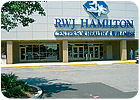
Three pools with a vast array of aquatic uses offer facility users the best of all worlds, but dehumidification design was critical at this facility because all three vessels have different evaporative rates and surrounding air space temperature needs.
The success of a 21st-century medical trend of combining hospital and health club services in one facility is as dependent on high-technology HVAC equipment as it is on medical and fitness technology.
The new 87,000-sq-ft RWJ Hamilton Center for Health & Wellness, in Mercerville, NJ, which opened last year, is a model example. RJW operates with amenities such as childcare, occupational therapy, cardiac rehabilitation, strength training, aerobics, physical therapy, pulmonary rehab, community health education, women's health services, administrative offices, and a juice bar, plus many other state-of-the-art fitness facilities.
It's the 9,000-sq-ft natatorium, however, that serves as one of the major focal points, according to Stephen D. Kay, managing partner, Fitness & Wellness Professional Services, LLC, which owns and operates the facility with joint venture partner, Robert Wood Johnson University Hospital Hamilton.
The center's natatorium is one of the most foundational factors in creating the unique synergy between fitness and health care, according to Rick Piecara, manager of engineering for the Philadelphia office of architecture and engineering firm, HLM Design - a division of Heery International. "The challenge to this unique natatorium design is to ensure that medically based wellness, therapy, and rehabilitation programs can be provided along with fitness center aquatic programs," said Piecara.
RJW is similar in design to the Princeton, NJ-based Princeton Fitness & Wellness Center, another Fitness & Wellness Professional Services project, but developed in conjunction with a different hospital group, the University Medical Center at Princeton, Princeton, NJ.
LAPPING IT UP
HLM Design's solution with the Princeton prototype was three separate pools with individual water temperatures and functions in one large room to provide access for both rehabilitation patients and fitness club patrons. For clinical wellness, fitness, and club competitive swim training programs, there's a 25-yd-long, five-lane lap pool. The second pool is a 30-ft by 30-ft, 4-1/2-ft-deep pool with both portable and in-pool hydraulic lifts for individual and group health care therapy as well as club aerobics and aquatic classes. The third vessel is a 15-ft-dia, 10-person whirlpool spa for both health care and club therapy.While this diverse natatorium might offer facility users the best of all worlds, dehumidification design is critical because all three vessels have different evaporative rates and surrounding air space temperature needs. Piecara designed the natatorium HVAC with a warm zone and cool zone supplied by two energy recycling dehumidifiers by Dectron Internationale, that efficiently recycle energy to heat the pool and therapy pool water.
The dehumidifiers are completely separate from the rest of the building's Carrier Corp. DX rooftop and VAV (with terminal heating coils) box HVAC system. While controlling the entire building, a Carrier Comfort WORKS system only receives monitoring information from Dectron's proprietary Supervisaire® system which controls the zones in the natatorium. "We always use a packaged mechanical dehumidifier for natatorium projects that allow us to control the indoor environment separately from the rest of the building regardless of the outside air conditions," said Piecara.
The Dry-O-Tron® RS-150 controls the cooler zone of the lap pool to 55% rh with 8,500-cfm of 84°F air while simultaneously heating the water to 80°. Meanwhile, the 6,500-cfm, RS-100 supplies 50% rh and an 86° space temperature over the warmer zone of the 85° therapy pool water and the 104° spa," said Piecara, whose firm has decades of experience designing natatoriums of various sizes.
CATCHING A WAVE OF THE FUTURE
Assisting HLM in the design of the dehumidifier was David Moore, sales engineer, Sass, Moore & Associates, who suggested the unit come with a factory pre-charged integrated condenser and pre-wired to ease installation and startup.Princeton and RJW mark the third and fourth facilities, respectively, the Fitness & Wellness Professional Services has completed, and several more projects are on the drawing board, which also highlight the natatorium as a focal point. "Combining health care with preventative wellness services in a single facility is the wave of the future," added Kay.
